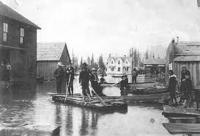Mankind has been beset by the threat of floods since time immemorial. The Canadian Military Engineers have played a major role in limiting the damage from these inundations. In the Spring of 1948, the lower Fraser Valley in British Columbia was threatened by a major flood. By 1 June, a state of emergency was declared by the Province and control over the emergency operation was passed over to the Canadian Army.
A total of approximately 3000 officers and men of the Active and Reserve Forces were called out. 23rd Field Squadron and the Royal Canadian School of Military Engineering in Chilliwack, BC were employed on the dykes in the Chilliwack area while the squadrons of the 7th Field Engineer Regiment (Militia) were deployed on the dykes in the New Westminster area.
In the Chilliwack area, the emergency force erected several temporary Bailey bridges, undertook salvage and rescue operations, and removed log jams on the Vedder River with explosives. Residents and farm animals, including 15,000 chickens were transported to safety by boat when some 10 square miles of farmland was flooded due to a breach in the dykes near the outfall of the Vedder Canal. The action of the Military Engineers was a major factor in avoiding a greater disaster.
After the flood subsided, the Military Engineers demolished a badly damaged bridge at Merritt, BC and started a topographical survey of Nicomen Island to assist the Fraser Valley Dyking Board to restore the dykes protecting the island.
